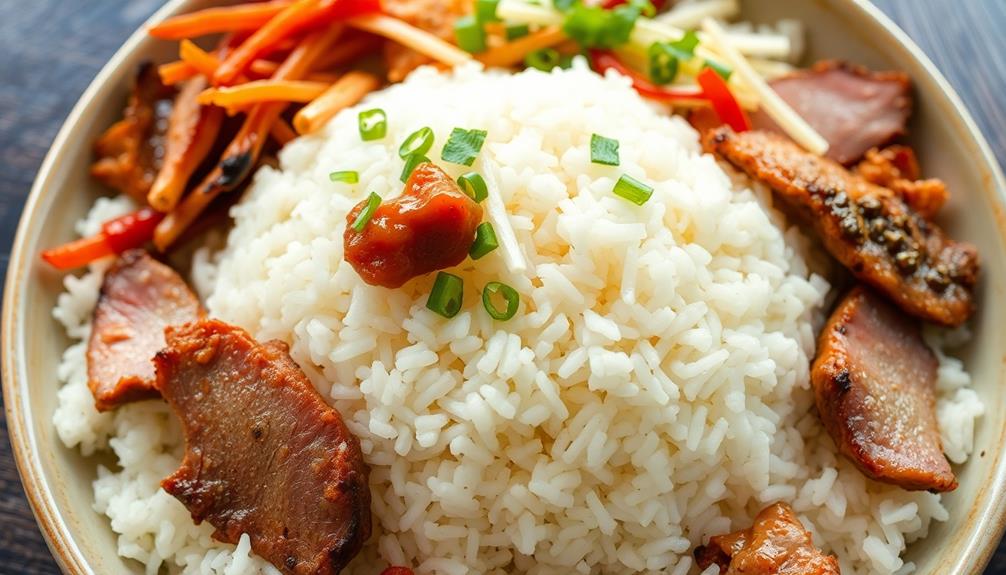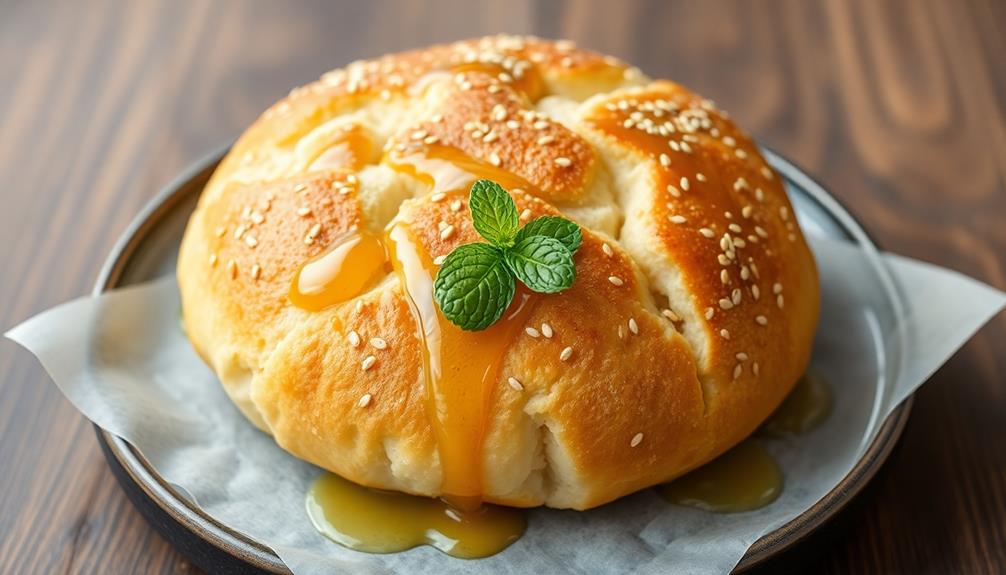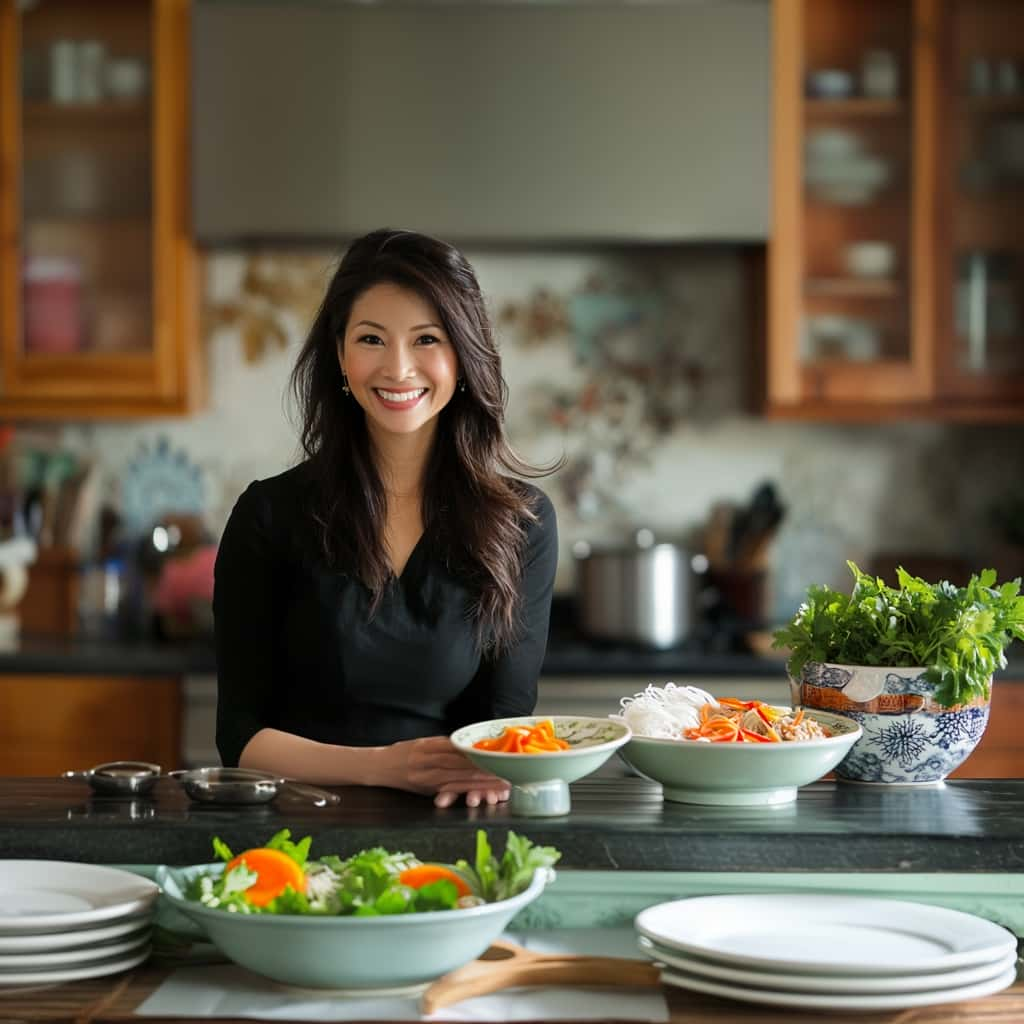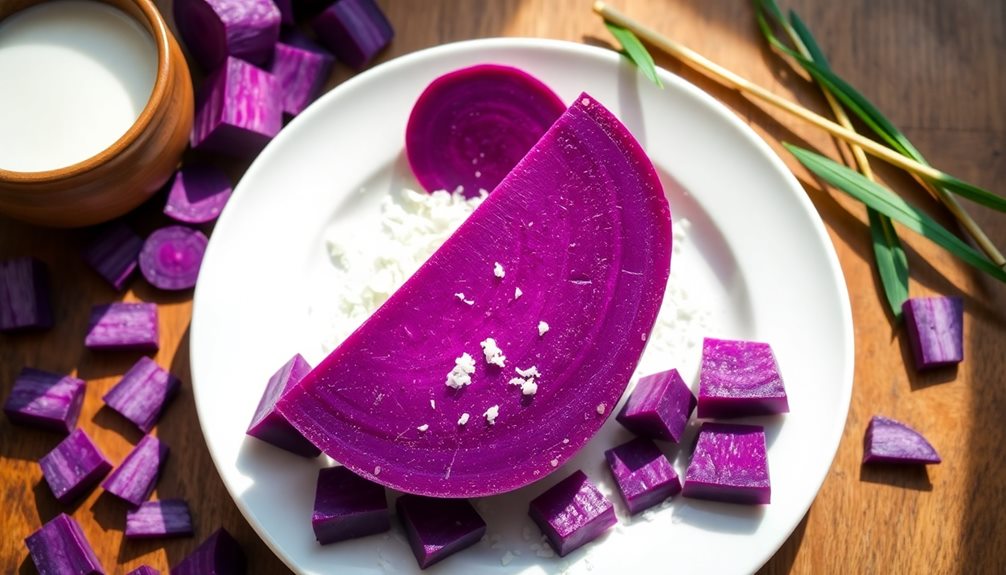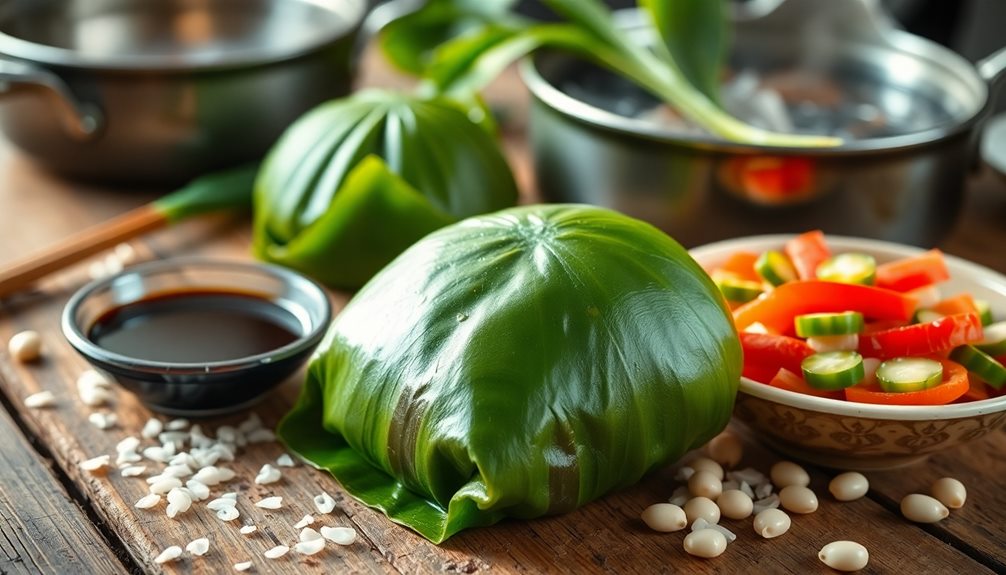Com Tam, or 'broken rice,' is a beloved Vietnamese dish with a rich history! It started as a meal for the working class, using up leftover rice grains. But today, this comforting dish is enjoyed by everyone. The tender, chewy rice is the star, often served with savory meats, fried eggs, fresh herbs, and tangy pickled veggies. It's a perfect balance of flavors and textures in each bite. Com Tam is a true symbol of Vietnamese culture, representing resourcefulness, community, and the joy of shared meals. Want to learn more about this classic dish? There's plenty to discover!
Key Takeaways
- Com Tam is a beloved Vietnamese dish made from affordable and resourceful broken rice grains, often served with an array of savory toppings and accompaniments.
- The dish holds cultural significance, representing the resourcefulness and culinary creativity of Vietnamese working-class communities.
- Com Tam features a delicate balance of textures, with chewy broken rice as the base, complemented by flavorful toppings and pickled vegetables.
- The dish is enjoyed as both a quick meal and a leisurely dining option, often accompanied by refreshing beverages.
- Com Tam transcends mere sustenance, fostering connection and togetherness, and representing a significant aspect of Vietnamese culinary heritage.
History
Originating in Vietnam, com tam, or broken rice, has long been a staple dish enjoyed by the country's working-class population. This humble, yet delicious, meal was born out of necessity, as farmers and laborers would often have leftover, or "broken," grains of rice from the harvesting process. Rather than let this precious resource go to waste, they ingeniously incorporated the broken rice into a hearty, satisfying dish.
Today, com tam remains a beloved part of Vietnamese cuisine, cherished for its simplicity and comforting flavors. The dish typically features steamed, broken rice served with a variety of toppings, such as grilled pork, egg, and pickled vegetables. The combination of textures and tastes creates a harmonious and fulfilling meal that nourishes both the body and the soul.
Whether enjoyed at a bustling street stall or in the comfort of one's home, com tam continues to be a culinary touchstone for the Vietnamese people, a testament to the resourcefulness and culinary creativity that has defined their rich food culture for generations.
Recipe
Com Tam, or broken rice, is a beloved Vietnamese dish that originated in the Mekong Delta region. The dish features fragrant, partially broken rice grains that are typically served with an array of flavorful toppings and accompaniments. Aside from the traditional toppings like grilled pork, shredded pork skin, and a fried egg, com tam can also be enjoyed with a variety of other ingredients such as pickled vegetables, steamed pork loaf, and fish sauce. One popular variation of com tam is called “com tam suon bi cha,” which includes broken rice served with grilled pork chop, shredded pork skin, and steamed pork loaf. Many families have their own special com tam chao recipe that has been passed down through generations.
The unique texture and flavor of the broken rice create a dining experience that's both comforting and satisfying. This recipe will guide you through the steps to prepare an authentic Com Tam dish in your own kitchen.
Ingredients:
- 2 cups broken rice
- 1 lb pork chops, thinly sliced
- 2 eggs, beaten
- 1 cucumber, sliced
- 2 carrots, julienned
- 1 cup bean sprouts
- 2 tbsp fish sauce
- 1 tbsp sugar
- 2 cloves garlic, minced
- 1 tsp ground black pepper
- Sliced green onions, for garnish
Instructions:
Cook the broken rice according to package instructions. In a skillet, sauté the pork chops until browned and cooked through. Remove from heat and set aside.
In the same skillet, scramble the eggs until fully cooked. Arrange the cooked rice, pork chops, scrambled eggs, cucumber, carrots, and bean sprouts on a plate.
In a small bowl, combine the fish sauce, sugar, garlic, and black pepper. Drizzle the dressing over the dish and garnish with sliced green onions. Gently toss the ingredients to ensure even coating, allowing the flavors to meld together beautifully. Serve immediately to retain the freshness and vibrant taste of the dish. This light and flavorful recipe is perfect for incorporating into Christmas Eve feast traditions, offering a delightful balance of savory and sweet to complement richer holiday staples.
When preparing Com Tam, it's important to use the correct type of broken rice, which can be found at Asian grocery stores or specialty markets. The broken rice grains should have a soft, fluffy texture and a slightly nutty flavor.
Additionally, you can experiment with different toppings and accompaniments, such as grilled pork belly, shredded pork, or sliced Vietnamese sausage, to create your own unique version of this classic dish.
Cooking Steps
First, you'll want to rinse the rice thoroughly until the water runs clear.
Next, let the rice soak in water for a bit before draining it through a sieve.
Then, it's time to cook the rice on the stove.
Step 1. Rinse Rice Thoroughly Until Water Runs Clear
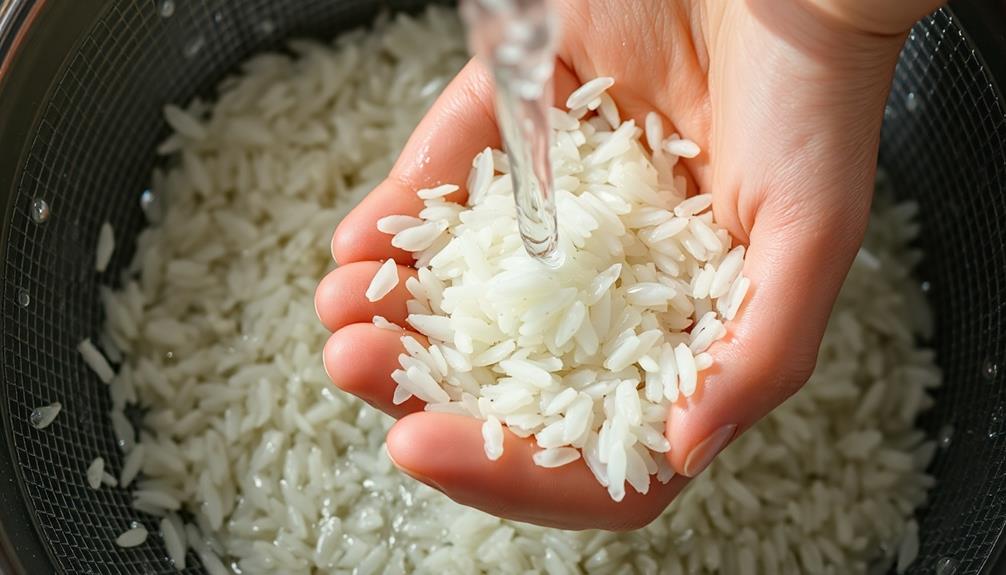
Thoroughly rinse the rice in a fine-mesh strainer or sieve until the water runs clear. You'll be amazed at how much grime and starch comes off the rice!
Keep rinsing and swishing it around until the water looks crystal clear. This step is super important, as it removes any impurities and helps the rice cook up nice and fluffy.
Now, give the rinsed rice a good shake to remove any excess water. You want it to be just damp, not dripping wet.
Next, transfer the rice to your pot or rice cooker. Add fresh, cold water according to the package instructions or your own preferred rice to water ratio.
Get ready for the delicious aroma to fill your kitchen as the rice cooks to perfection! Rinsing thoroughly is the key to making the best, most flavorful com tam.
With this simple step, you're well on your way to an authentic and satisfying Vietnamese dish.
Step 2. Soak Rice in Water
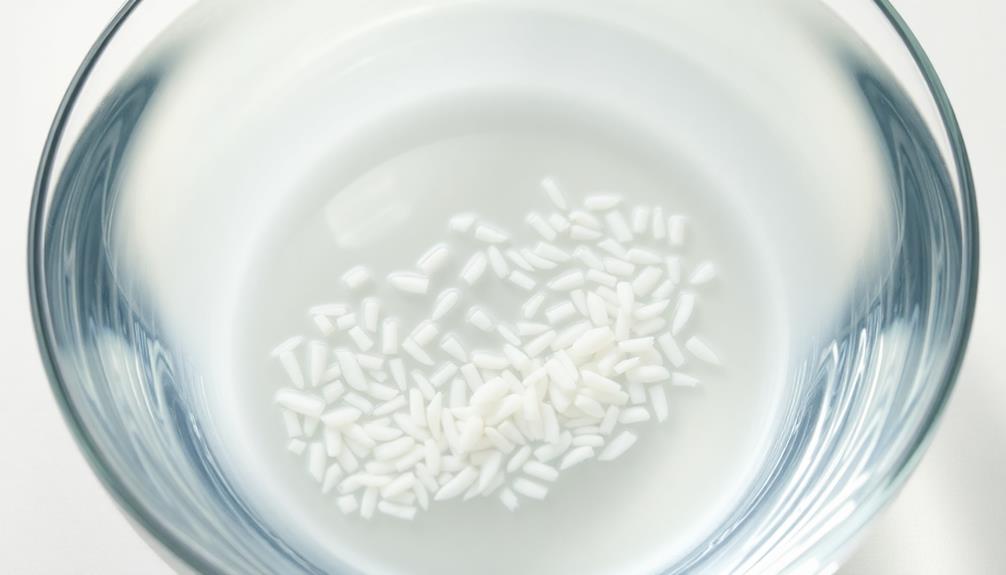
After thoroughly rinsing the rice, let's move on to the next step. Grab your bowl of freshly rinsed rice and fill it with cool, clean water. The rice will need to soak for at least 30 minutes, so be patient! This step is crucial, as it helps the rice grains soften and plump up.
While the rice is soaking, you can start preparing the other delicious ingredients for your com tam dish.
As the rice soaks, you'll notice the water gradually turning a cloudy, milky color. This is totally normal – it just means the rice is releasing some of its starch.
Once the 30 minutes are up, carefully drain the rice through a mesh strainer. You're now ready to move on to the next step of cooking the perfect com tam! Get excited, because your tasty Vietnamese meal is really starting to come together.
Step 3. Drain Soaked Rice Through Sieve
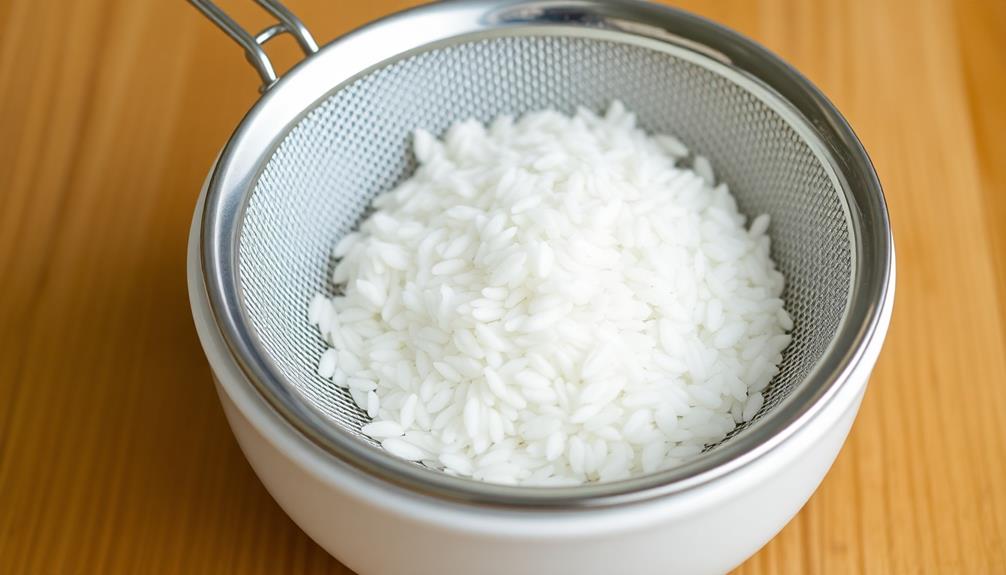
Once the rice has finished soaking, carefully pour it through a fine-mesh sieve or colander. This will allow the excess water to drain away, leaving you with perfectly plump and ready-to-cook rice!
Be sure to give the sieve a gentle shake to help the water drain out faster. You don't want any soggy rice in your final dish.
With the rice now drained, you can move on to the next step. Gently fluff the rice with a fork to separate the grains and prevent them from sticking together. This will ensure your com tam has a lovely, fluffy texture.
You can even rinse the rice again under cool running water if you'd like to remove any last bits of starch.
Now that your rice is all set, it's time to start cooking! The next step is to transfer the drained rice to a pot or pan and get it sizzling on the stove.
Stay tuned for the next tasty part of the process.
Step 4. Cook Rice on Stove
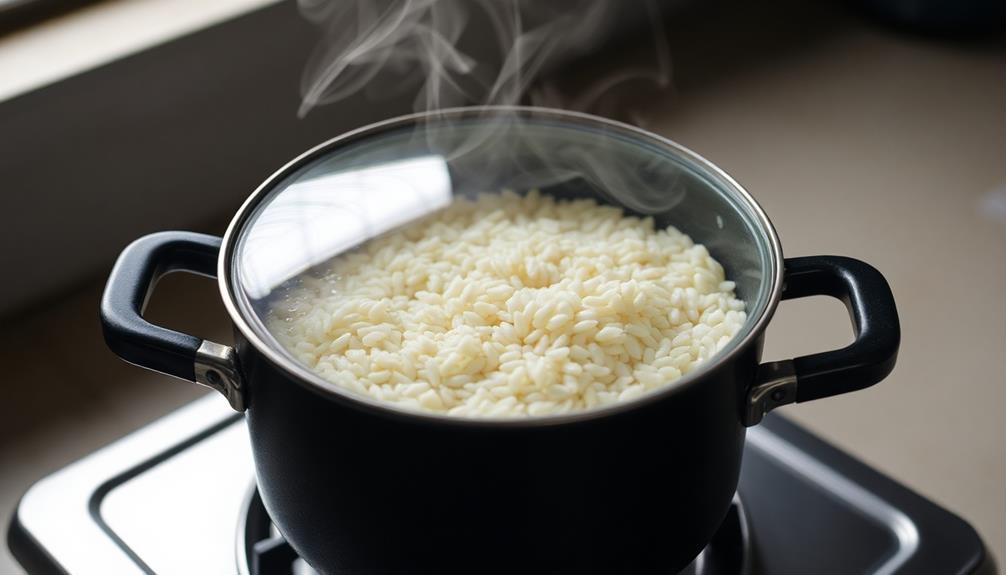
Heat a large skillet or wok over medium-high heat.
Once it's nice and hot, carefully add the drained, soaked rice. It'll sizzle as it hits the pan – that's a good sign! Stir the rice around with a wooden spoon or spatula, making sure every grain gets cooked evenly.
After a few minutes, pour in some water – just enough to cover the rice. Let it simmer, stirring occasionally, until the liquid is absorbed and the rice is tender. Yum, can you smell that delicious aroma already?
Now, turn the heat down to low and cover the pan with a lid. Let the rice steam for about 10 minutes. This'll make the grains extra fluffy and perfect.
When the time's up, remove the lid and fluff the rice with a fork. It's ready to serve! Scoop it onto plates and enjoy your homemade Com Tam. Mmm, doesn't it look amazing?
Step 5. Serve Over Pickled Vegetables
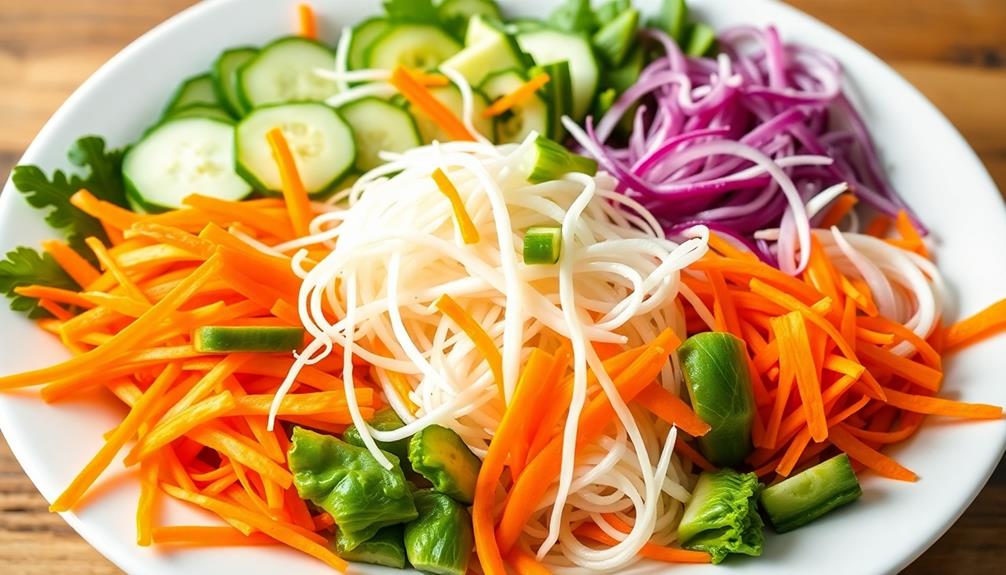
To serve the com tam, you'll want to prepare some tasty pickled vegetables to complement the flavors. Start by slicing up some crisp carrots, crunchy radishes, and juicy cucumbers into thin, uniform pieces.
Place them in a bowl and pour in a mixture of rice vinegar, sugar, and a pinch of salt. Gently toss the veggies until they're evenly coated. Let the pickles sit for at least 30 minutes, or up to a few hours, so the flavors can meld together.
When you're ready to serve, spoon the fragrant, steaming com tam onto plates. Top each portion with a generous helping of the vibrant, tangy pickled vegetables.
The cool, refreshing crunch of the pickles will perfectly offset the tender, savory rice. Garnish with fresh herbs like cilantro or mint for an extra burst of flavor.
Get ready for your taste buds to dance with delight as you enjoy this classic Vietnamese meal!
Final Thoughts
Com Tam, or broken rice, is a beloved Vietnamese dish that transcends mere sustenance.
It's a comforting and satisfying meal that warms the soul and brings people together. As you savor each bite, the flavors and textures meld together in perfect harmony, creating a symphony of deliciousness that's hard to forget.
Whether you're enjoying Com Tam as a quick lunch or a leisurely dinner, the experience is always memorable.
The tender yet chewy grains of rice, the tangy pickled vegetables, and the savory accompaniments work in perfect symphony to satisfy your palate.
It's a dish that's not just about nourishment, but also about the joy of sharing a meal with loved ones.
Frequently Asked Questions
Is Com Tam Considered a Healthy Dish?
While the healthiness of a dish can vary, it's generally best to consider the specific ingredients and preparation methods. Some dishes may be more nutritious than others, so it's worth looking into the specifics of this one.
Can Com Tam Be Made Gluten-Free?
Yes, you can make com tam gluten-free. Simply use gluten-free ingredients like rice flour, tamari sauce, and gluten-free proteins. With a few simple substitutions, you can enjoy this classic Vietnamese dish without the gluten.
How Long Does Com Tam Typically Take to Prepare?
Preparing com tam typically takes around 45 minutes to an hour. You'll need to cook the rice, prepare the toppings, and assemble the dish, but the hands-on time is relatively quick once you've got the components ready.
What Are the Best Side Dishes to Serve With Com Tam?
When serving a hearty dish, you'll want to balance it out with some tasty side dishes. Consider adding a fresh salad, pickled vegetables, or a simple steamed vegetable to complement the main course.
Are There Any Variations of Com Tam Worldwide?
Yes, there are variations of this classic dish worldwide. From Filipino silog meals to Korean bibimbap, you'll find unique interpretations that showcase the versatility of broken rice in different culinary traditions.
